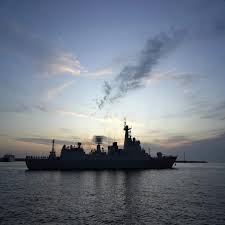Maritime Security Belt 2025

- 16 Mar 2025
In News:
Amid rising tensions over Iran’s expanding nuclear program and threats from Yemen's Houthi rebels, China, Iran, and Russia conducted the Maritime Security Belt 2025 naval exercise in the Gulf of Oman, strategically located near the Strait of Hormuz. This region is of global significance as it serves as a major maritime route, through which a fifth of the world’s crude oil is transported daily.
Key Highlights of the Exercise
- Location: Gulf of Oman, near the Strait of Hormuz, connecting the Persian Gulf to the open seas. This waterway is crucial for global energy supplies and trade.
- Participating Navies:
- Iran: State-run media highlighted the drills as a show of strength, particularly after Israeli strikes targeted Iran’s defense and missile programs.
- Russia: Participated with corvettes Rezky and Aldar Tsydenzhapov as well as the tanker Pechenega. Russia continues to rely on Iran for drone supplies, particularly in the ongoing war in Ukraine.
- China: Sent guided-missile destroyer Baotou and supply ship Gaoyouhu. China maintains deep ties with Iran, especially in the oil sector, despite facing Western sanctions.
- Operational Objectives:
- The exercise aimed to enhance coordination and operational synergy between the three nations, with a focus on maritime security, countering threats to shipping lanes, and addressing global security challenges.
- It featured live-fire drills, night operations, and complex naval maneuvers, ensuring the readiness of all three navies to respond to maritime threats.
- Regional Significance: The Gulf of Oman serves as the only maritime access for Iran to the open seas, making it critical for global trade. The Strait of Hormuz is particularly significant as it handles a significant portion of the world’s oil trade.
Strategic Context and Implications
- Nuclear Tensions: Iran's nuclear program, which has drawn concerns from both Israel and the U.S., remains a central issue in the region. The exercises coincide with the growing concerns over Iran’s stockpiling of uranium enriched to near weapons-grade levels, despite Tehran's assertions that its nuclear ambitions are peaceful.
- Impact of Drills: These joint naval exercises highlight the growing influence of China and Russia in the Middle East, both of which have strategic ties with Iran. While these countries do not patrol the wider Middle East region, their naval presence in the Gulf signals their deepening involvement in the region’s security dynamics, particularly in opposition to the U.S.-led presence.
- Yemen's Role: The Houthi rebels in Yemen have previously targeted international shipping in the Red Sea and Bab el-Mandeb Strait, and have threatened to resume attacks unless humanitarian aid is allowed into Gaza. The instability in the region further complicates security, as seen in the potential for maritime disruptions.
Geopolitical Dimensions
- China’s Interests: China, as a major consumer of Iranian crude oil, continues to engage with Iran despite facing Western sanctions. These drills serve as a symbol of China’s increasing military presence and its growing role in the Middle East, particularly in energy security.
- Russia’s Involvement: Russia's reliance on Iran for bomb-carrying drones in the Ukraine conflict further deepens the military relationship between the two nations. The maritime drills highlight Russia’s interest in securing its position in the Middle East amidst growing tensions with the West.
- U.S. Interests: The U.S., which monitors the region through its 5th Fleet based in Bahrain, remains cautious of the growing military cooperation between China, Russia, and Iran. The drills, especially the interference with GPS systems, have raised concerns about regional stability and the ability to ensure free navigation through critical maritime chokepoints.
